Potential Reservoirs and Traps
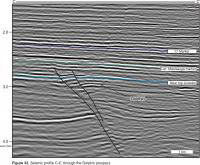
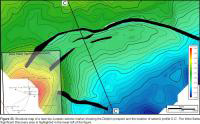
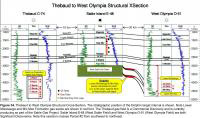
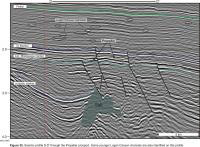 The CNSOPB has identified a number of undrilled prospects with considerable hydrocarbon potential on Parcel 1. These undrilled structures are numbered 1-3 on figure 30. It should be noted that other prospects are likely present on the parcel which further seismic mapping may uncover. These prospects may include plays such as subtle drapes over basement highs or stratigraphic traps. The prospects identified by the CNSOPB are discussed below.
The CNSOPB has identified a number of undrilled prospects with considerable hydrocarbon potential on Parcel 1. These undrilled structures are numbered 1-3 on figure 30. It should be noted that other prospects are likely present on the parcel which further seismic mapping may uncover. These prospects may include plays such as subtle drapes over basement highs or stratigraphic traps. The prospects identified by the CNSOPB are discussed below.
Dolphin (1)
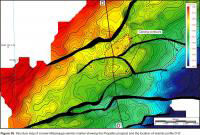 The Dolphin prospect is located approximately five kilometers north of Sable Island, figure 30. The structure is a fault bounded rollover anticline, figure 32. The trap is defined by dip closure to the east and southeast, fault dependent closure to the north and south and a stratigraphic pinch-out to the west against the West Sable salt diapir, figure 33. The interval under closure extends from the early Cretaceous lower Missisauga to the mid to late Jurassic Mic Mac Formation. Within this target interval the reservoirs are interpreted to be stacked fluvial deltaic sands similar to those encountered in nearby wells, figure 34.
The Dolphin prospect is located approximately five kilometers north of Sable Island, figure 30. The structure is a fault bounded rollover anticline, figure 32. The trap is defined by dip closure to the east and southeast, fault dependent closure to the north and south and a stratigraphic pinch-out to the west against the West Sable salt diapir, figure 33. The interval under closure extends from the early Cretaceous lower Missisauga to the mid to late Jurassic Mic Mac Formation. Within this target interval the reservoirs are interpreted to be stacked fluvial deltaic sands similar to those encountered in nearby wells, figure 34.
Propeller (2)
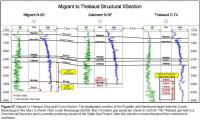 The Propeller structure is a group of three individual prospects separated by faults, and is located 18 km west of Sable Island, figure 30. The Propeller prospects are a group of fault bounded rollover anticlines formed by movement of the underlying salt caused by sediment loading, figure 35. The traps are a combination of simple and fault dependent closures that extend from the early Cretaceous lower Missisauga to the mid to late Jurassic Mic Mac Formation, figure 36. Within this target interval the reservoirs are interpreted to be stacked fluvial deltaic sands, figure 37.
The Propeller structure is a group of three individual prospects separated by faults, and is located 18 km west of Sable Island, figure 30. The Propeller prospects are a group of fault bounded rollover anticlines formed by movement of the underlying salt caused by sediment loading, figure 35. The traps are a combination of simple and fault dependent closures that extend from the early Cretaceous lower Missisauga to the mid to late Jurassic Mic Mac Formation, figure 36. Within this target interval the reservoirs are interpreted to be stacked fluvial deltaic sands, figure 37.
Manhasset (3)
The Manhasset structure contains a group of elongate prospects separated by faults and is located due east of Dolphin and five kilometres north of Sable Island, figure 30. The Manhasset prospects are a group of fault bounded rollover anticlines. The traps are primarily fault dependent closures, however minor simple closure is also present. The interval under closure extends from the early Cretaceous lower Missisauga to the mid to late Jurassic Mic Mac Formation. Within this target interval the reservoirs are interpreted to be stacked fluvial deltaic sands similar to those encountered in nearby wells, figure 37.
Cretaceous Fluvial Channel Belts
Numerous Early Cretaceous fluvial channel systems have been identified on Parcel 1 in the lower Logan Canyon Formation and Upper Missisauga, figure 35. These channel systems are widespread and can be mapped over the entire parcel. The size of these systems varies, however a number of channels with widths over a kilometre have been mapped and many are laterally continuous for 10’s of kilometres. Figures 26, 27, 28 of the Sediment Delivery section of this Call for Bids package show numerous examples of these channel systems as they appear on flattened and sliced seismic data in other locations on the Scotian Shelf. If sands are present in these channels they are likely encased in marine shales resulting in stratigraphic traps. These fluvial channel belts have hydrocarbon potential as a stratigraphic play within the Missisauga and Logan Canyon formations.